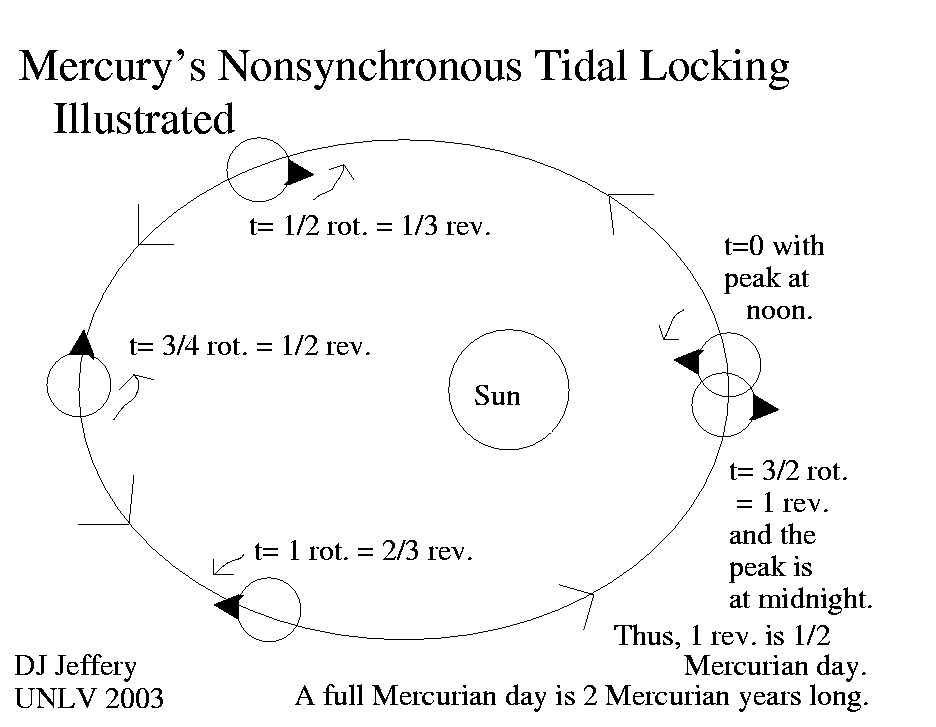
Caption: Mercury's orbit exhibits a 3:2 spin-orbit resonance which is illustrated in the diagram.
Features:
- The relevant periods and relationships among them:
- orbital period (relative to the observable universe): Mercurian orbital rotation period P_O = 87.9691 days = 0.240846 yr = (3/2)*P_A = (1/2)*P_D.
- axial rotational period (relative to the observable universe): Mercurian axial rotational period P_A= 58.646 days = (2/3)*P_O = (1/3)*P_D.
- synodic day (i.e., rotation period relative to host star): Mercurian synodic day P_D = 175.942 days = 2*P_O = 3*P_A (NASA: Mercury fact sheet, 2021).
- By following the progress of the artificial giant
mountain in the
diagram,
one can see clearly how the
3 relevant periods
relate to each other.
- To explicate one detail of the diagram:
Say you land on Mercury on the equator just at noon on top of a giant mountain.
Now 3/2 axial rotation periods later, 1 Mercurian year has passed (i.e., Mercurian orbital rotation period P_O = 87.9691 days = 0.240846 yr = (3/2)*P_A = (1/2)*P_D has passed).
But since it is 3/2 axial rotation periods, it is now midnight for you.
It takes another 3/2 axial rotation periods to bring you back to noon.
Thus the Mercurian synodic day P_D = 175.942 days = 2*P_O = 3*P_A (i.e., noon to noon) is 3 axial rotation periods = 2 orbital periods (i.e., 2 Mercurian years).
- In the case of Mercury,
the large eccentricity of the
Mercurian orbit
(e=0.0.205630 ≅ 20 %)
caused it to settle into a stable
3:2 spin-orbit resonance
and this is according to one theory
happened within 20 Myr of
Mercury's formation
(Wikipedia: Mercury:
Spin-orbit resonance).
Subtle stabilizing effects damp out any changes in the ratios set by the 3:2 spin-orbit resonance caused by astronomical perturbations.
- A resonance is
tendency for large and/or stable oscillations.
In the case of Mercury's orbit, the oscillations are axial rotations and orbit rotations.
- The
3:2 spin-orbit resonance
situation
gives 3
rotation periods
= 3 * 58.646 days ≅ 175.942 days
nearly exactly equal to the time of
2
orbital periods
2 * 87.9691 days ≅ 175.942 days
(see Wikipedia: Mercury;
Wikipedia:
Mercury: Spin-orbit resonance;
NASA: Mercury fact sheet, 2021).
From the specialized formulae for the synodic period (see Orbit file: synodic_period.html), we have, in fact, Mercurian day equal to 2 orbital periods = 175.9382 days. The diagram also shows why this must be so (as aforesaid).
The accurate Mercurian day = 175.942 days (NASA: Mercury fact sheet, 2021). The discrepancy between our calculated value and NASA's may be due to the specialized formulae being based on assumption that Mercury having a circular orbit which is NOT the case. There might be other reasons for the slight discrepancy: e.g., astronomical perturbations and/or observational error.
- Before Doppler radar
observations in 1965,
people thought Mercury
would be tidally locked
to the Sun
(see Wikipedia:
Mercury: Spin-orbit resonance).
- Old scifi
novels and
short stories
(pre-1965)
often make a point of
the supposed tidal locking
of Mercury
and sometimes give
Mercury
a habitable zone
at its fixed terminator
(the line between daytime and
nighttime).
Image link: Itself.
Local file: local link: mercury_3_2_spin_orbit_resonance.html.
File: Mercury file: mercury_3_2_spin_orbit_resonance.html.